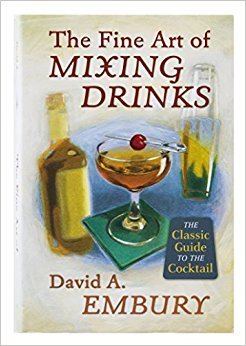8.8 /10 1 Votes8.8
Originally published 1952 | 4.4/5 Goodreads | |||||||||||||||||||||||||||||||||
 | ||||||||||||||||||||||||||||||||||
Similar The Joy of Mixology, The World's Drinks An, How to Mix Drinks: Or - The Bon, Harry's ABC of Mixing C, Aprender a Dibujar Un Metodo G | ||||||||||||||||||||||||||||||||||
The fine art of mixing drinks review by better cocktails at home
The Fine Art of Mixing Drinks is a book about cocktails by David A. Embury, first published in 1948. The book is noteworthy for its witty, highly opinionated and conversational tone, as well as its categorization of cocktails into two main types: aromatic and sour; its categorization of ingredients into three categories: the base, modifying agents, and special flavorings and coloring agents; and its 1:2:8 ratio (1 part sweet, 2 parts sour, 8 parts base) for sour type cocktails.
Contents
- The fine art of mixing drinks review by better cocktails at home
- Basic principles
- Components of a cocktail
- Categories of cocktails
- Six basic drinks
- Chapters
- Reception
- Editions
- References
Basic principles
Embury first outlines some basic principles for fashioning a quality cocktail:
Embury stresses frequently that the drink will never be any better than the quality of the cheapest ingredient in it, and hence he stresses constantly the need for the highest quality spirits, liqueurs, cordials, and modifiers (fresh squeezed lemons, etc.). He also repeatedly stresses that a cocktail, in the classic sense (a before-dinner drink) should have no more than the slightest touch of sweetness to it, and deplores the use of drinks like the Brandy Alexander as pre-prandial cocktails, as they dull rather than sharpen the appetite. He does not denigrate sweet drinks as such, but rather points out that they are excellent after dinner or mid-afternoon drinks accompanying cake or chocolate cookies, but they are anathema as a "cocktail" before a large meal.
In terms of IBA Official Cocktails, Embury describes classic Before-Dinner Cocktails, which whet the appetite, not other categories.
Components of a cocktail
Embury breaks all cocktail ingredients down into three categories:
The base is the principal ingredient of the cocktail. It is typically a single spirit such as rum, gin, or whiskey, and typically makes up 75 percent or more of the total volume of the cocktail before icing.
The modifying agent is the ingredient that gives the cocktail its character. Its function is to soften the raw alcohol taste of the base while enhancing its natural flavor. Typical modifying agents are aromatic wines (such as vermouth) and spirits (such as Fernet Branca or Amer Picon), bitters, fruit juices and "smoothing agents" such as sugar, eggs, and cream.
Special flavoring and coloring agents include liqueurs (such as Grand Marnier or Chartreuse), Cordials, Bitters like Angostura Bitters, etc. and non-alcoholic flavored syrups (such as Grenadine or Orgeat syrup). These are typically used in place of simple syrup, and are to be used sparingly.
Categories of cocktails
Embury breaks all cocktails down into two categories:
Cocktails of the Aromatic Type use as modifying agents bitters or aromatic wines or spirits.
Cocktails of the Sour Type use as modifying agents a fruit juice (typically, lemon or lime) and sugar. For these a ratio of 1 part sweet to 2 parts sour to 8 parts base is generally recommended. However, Embury makes it very clear that he thinks the idea that a drink must be made according to one exact recipe preposterous, and that the final arbiter is always your taste. He suggests trying different ratios, finding the one that is most pleasing to you, and sticking with it.
Once one understands the basic components of each type of drink, new cocktails can be created by substituting a different base or modifying agent or by adding a special flavoring or coloring agent. A daiquiri, for example, is nothing more than a whiskey sour with rum substituted for whiskey as the base and lime juice substituted for lemon juice as a modifying agent. An entire chapter of the book ("Roll Your Own") is dedicated to this premise.
Six basic drinks
Embury's six basic drinks are the Daiquiri, the Jack Rose, the Manhattan, the Martini, the Old Fashioned, and the Sidecar. Embury's preferred recipe for each is:
Shake with lots of finely crushed ice and strain well into a chilled cocktail glass.
Shake vigorously with ice and strain into a cocktail glass. Garnish with a twist of lemon, if desired.
Stir with ice, strain into a cocktail glass and serve garnished with a Maraschino cherry.
Stir with ice, strain into a cocktail glass, twist lemon peel over the top and serve garnished with an olive, preferably one stuffed with any kind of nut. Embury also states that sherry is a nice substitute for vermouth.
In an old-fashioned glass, add bitters to simple syrup and stir. Add about 1 ounce of whiskey and stir again. Add two cubes of cracked, but not crushed, ice and top off with the rest of the whiskey. Twist lemon peel over the top and serve garnished with the lemon peel and a maraschino cherry.
Shake vigorously with ice and strain into a cocktail glass. Garnish with a twist of lemon, if desired.
Chapters
From the 1958 edition:
Reception
The book gained immediate popularity and quickly became one of the most referenced and cited cocktail books. The book was highly influential on generations of cocktail enthusiasts and professionals, including many who were responsible for today’s cocktail Renaissance, and it elevated Embury, an attorney who never worked within the liquor profession, to great levels of respect within the liquor profession.
Today, certain first editions of the book can go for upwards of $8,500.
